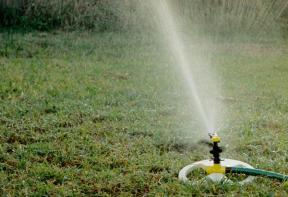In-ground irrigation
Install an in-ground irrigation system and you'll never have to turn the sprinkler on again
Tired of always having to run outside, set up the sprinkler, turn on the sprinkler, monitor the watering time, then turn off the sprinkler? I know I would be-if it weren't for the fact that it's my husband, Kevin, who's been doing it. Even for Kevin, though, who's not the complaining sort, his eureka moment to install the sprinkler system came when his plans for an initially small project to edge our driveway with interlocking bricks turned into a complete tearing up and repaving of the driveway. So, what better time to dig up the lawn as well?
There are several advantages to in-ground sprinkler systems: saving time and money are two prime benefits. Because you control exactly where, when and how water is applied-without needing to be physically present-you conserve water and have more free time. Also, there's no need to drag around a hose or leave it lying about, so there's less chance of tripping over one, plus your lawn will look neater.
Of the many DIY in-ground irrigation systems available, we chose the Orbit WaterMaster (see Sprinkler sources). Orbit's website, offers in-depth advice on installation, step-by-step instructions and a custom-designing program. Note: before starting, check your local bylaws and codes regarding permits and any requirements for backflow prevention devices. (In Markham, Ont., for instance, we needed a testable backflow valve.) Also, always arrange for utility companies to locate underground hazards before you dig.
Gauging your success
To ensure your system is a source of irrigation-not irritation-of prime consideration is your home's water capacity, i.e., the available flow of water. According to John Mytroen of Canada Rainmakers (distributors of Orbit), you need to know the gallons per minute for each unregulated outside faucet you intend to use. This will determine the number of sprinkler heads you can optimally run at the same time (each nozzle has a gallons per minute rating-see “Head Start” on last page). “The most common mistake people make,” says Mytroen, “is too many heads.”
To measure your static water pressure (no toilets flushing, washing machines running, and so forth), the bucket method is best. With the tap on full, if it takes 20 seconds to fill a two-gallon pail, for example, then your flow is six gallons per minute (gpm). For the faucets we tested, readings ranged from six gpm to nine gpm.
The diameter of your supply line also affects water capacity. To increase your gallons per minute, consider upsizing your water supply line. For example, if your supply line is 1/2"and your water flow is seven gpm, a 3/4" pipe will raise it to 13 gpm. In our case, the flow was very good, so the 1/2" line was sufficient.
The design plan we received from Orbit's Web site included sprinkler head placement and spray patterns, the number of watering zones required and a comprehensive shopping list of components and materials.
Winterization
Although you could install drain valves, they can be unreliable and hard to find once the system has been completed. An air compressor is more effective. Shut off the inside valve and blow out each zone using compressed air.
Sprinkler sources
In addition to Orbit WaterMaster, Rain Bird and Toro offer in-ground irrigation systems that homeowners can install themselves, available at home centres such as Home Depot, Home Hardware and Rona. For more retailers and product information, contact the respective companies: Orbit Irrigation Products, distributed by Canada Rainmakers, 905-371-9990; Rain Bird, 800-724-6247; Toro, 800-367-8676.
Sprinkler heads for small areas
There are a number of sprinkler head options, depending on the size of the area being watered and the types of plantings. While sprinkler heads differ from manufacturer to manufacturer, the basic mechanisms are the same. Make sure water patterns overlap to ensure complete coverage.
Sprinkler heads for large areas
Spring-loaded pop-up rotary heads cover a radius between 15' and 40', depending on the model. They come with several nozzles (from 0.5 to 12 gallons per minute), so their versatility is an advantage where low water pressure is an issue, and they have adjustable arcs from 30° to 360°.
Gear Drives: quieter than impact heads (no more “ticktickticktick”), with adjustable spray patterns
Impact Heads: recommended for rural areas; with no filter they work well with pond, river or stream water where “dirty water” might otherwise clog a nozzle
Medium areas
Suitable for Lawn areas and around larger garden beds.
Fixed Pattern: available in 2" or 4" versions with spring-loaded pop-ups. Patterns include side, centre or end strip, as well as a square pattern; range is typically about 24', depending on the nozzle used
Shrub Head: sprays in a circular pattern, adjustable from 90° to 360°; usually installed on risers to clear shrubs or taller plantings; also available in spring-loaded pop-ups
Small areas
Used to flood flower beds, groundcover or “spot water” particular trees and shrubs.
Mushroom Bubbler: adjustable from full flow to light trickle; sprays 360°, maximum 4' radius
Stream Bubbler: multi-stream patterns, with a range of jets from 90° to 360°. Maximum radius is typically 4'. A strip pattern is also available

To leave a comment, please log in












No comments